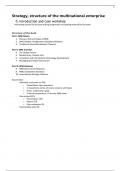Summary
SSMNE 2023 Summary
- Course
- Institution
Summary of the Strategy, Structure and Management of the Multinational Enterprise (SSMNE) course taught by Professor Sasha Albers in 2023. The summary includes all lessons (including the 2 guest lectures).
[Show more]



